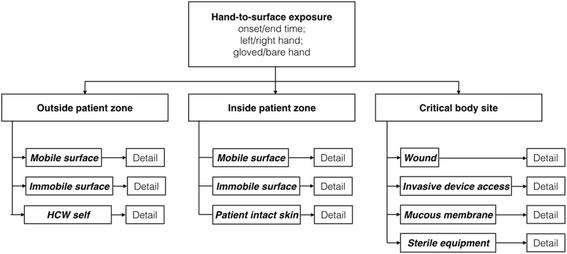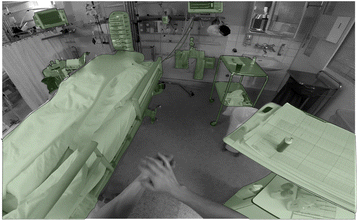"First-person view" of pathogen transmission and hand hygiene - use of a new head-mounted video capture and coding tool
- PMID: 29093812
- PMCID: PMC5661930
- DOI: 10.1186/s13756-017-0267-z
"First-person view" of pathogen transmission and hand hygiene - use of a new head-mounted video capture and coding tool
Abstract
Background: Healthcare workers' hands are the foremost means of pathogen transmission in healthcare, but detailed hand trajectories have been insufficiently researched so far. We developed and applied a new method to systematically document hand-to-surface exposures (HSE) to delineate true hand transmission pathways in real-life healthcare settings.
Methods: A head-mounted camera and commercial coding software were used to capture ten active care episodes by eight nurses and two physicians and code HSE type and duration using a hierarchical coding scheme. We identified HSE sequences of particular relevance to infectious risks for patients based on the WHO 'Five Moments for Hand Hygiene'. The study took place in a trauma intensive care unit in a 900-bed university hospital in Switzerland.
Results: Overall, the ten videos totaled 296.5 min and featured eight nurses and two physicians. A total of 4222 HSE were identified (1 HSE every 4.2 s), which concerned bare (79%) and gloved (21%) hands. The HSE inside the patient zone (n = 1775; 42%) included mobile objects (33%), immobile surfaces (5%), and patient intact skin (4%), while HSE outside the patient zone (n = 1953; 46%) included HCW's own body (10%), mobile objects (28%), and immobile surfaces (8%). A further 494 (12%) events involved patient critical sites. Sequential analysis revealed 291 HSE transitions from outside to inside patient zone, i.e. "colonization events", and 217 from any surface to critical sites, i.e. "infection events". Hand hygiene occurred 97 times, 14 (5% adherence) times at colonization events and three (1% adherence) times at infection events. On average, hand rubbing lasted 13 ± 9 s.
Conclusions: The abundance of HSE underscores the central role of hands in the spread of potential pathogens while hand hygiene occurred rarely at potential colonization and infection events. Our approach produced a valid video and coding instrument for in-depth analysis of hand trajectories during active patient care that may help to design more efficient prevention schemes.
Keywords: Hand hygiene; Observation; Transmission risk; Video.
Conflict of interest statement
Ethics approval and consent to participate
Due to the quality improvement scope of this study, the Ethics Review Board of the Canton of Zurich formally waived the need for ethics review. Signed consent was sought of patients or their relatives in accordance with the University Hospital Zurich regulations for videotaping and photography. Participants gave their oral consent after an in-depth explanation of the study goals and proceedings and could opt out at any time. Data were rendered anonymous in the coding database.
Consent for publication
Not applicable
Competing interests
The authors declare that they have no competing interests.
Publisher’s Note
Springer Nature remains neutral with regard to jurisdictional claims in published maps and institutional affiliations.
Figures



References
-
- Antimicrobial resistance. Geneva: World Health Organization; 2014. Available from: http://apps.who.int/iris/bitstream/10665/112642/1/9789241564748_eng.pdf. Accessed 19 Oct 2017.
-
- Boyce JM, Pittet D, Committee HICPA, Force HSAIHHT Guideline for hand hygiene in health-care settings. Recommendations of the healthcare infection control practices advisory committee and the HICPAC/SHEA/APIC/IDSA hand hygiene task force. Society for Healthcare Epidemiology of America/Association for Professionals in infection control/Infectious Diseases Society of America. MMWR Recomm Rep. 2002;51:1–45. - PubMed
LinkOut - more resources
Full Text Sources
Other Literature Sources

